'late 2013' Mac Pro 8-core 3.0GHz
versus
'early 2009' Mac Pro 8-core 2.93GHz
Originally posted Friday, February 21st, 2014, by rob-ART morgan, mad scientist
Our custom order 2013 Mac Pro 8-core finally arrived. Since we had a 2009 Mac Pro 8-core tower in the lab, we decided to to pit it against the new Mac Pro.
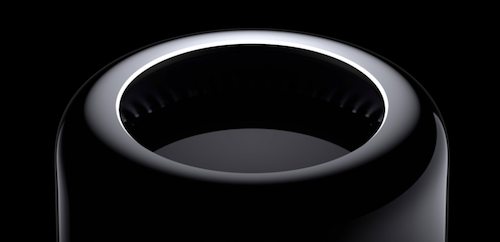
CPU GRAPH LEGEND
8c 3.0GHz nMP = 'late 2013' Mac Pro Xeon E5-1680 v2 @3.0GHz 8-Cores with 32G of 1866MHz DDR3
8c 2.93GHz MPt = 'early 2009' Mac Pro Xeon X5570 @2.93GHz 8-Cores with 20G of 1066MHz DDR3
Both were running OS X Mavericks 10.9.1.
CPU CRUNCH TESTS
Cinebench R15 -- Render 3D Model using all cores. (LARGER number means FASTER CB Rating)

Geekbench 3 -- Here is the overall score for 64-bit performance combining Integer, Floating Point, and Memory (HIGHER score means FASTER.)

After Effects CC -- We used old faithful, Total Benchmark Project, and the Multiprocessing option in Preferences to stress all real and virtual cores. (LOWER number in Seconds means FASTER.)

Aperture 3 -- With the Noise Ninja Plug-in installed, we timed how long it took to apply noise reduction to 50 raw photos. (LOWER number in Seconds means FASTER.)

HandBrake -- It utilizes all cores to transcode a video clip. We transcoded a 2 minutes WildLife HD H.264 clip to the iPad MP4 preset. (LOWER number in Seconds means FASTER.)

GPU STRESS TESTS
For the GPU tests, the 'early 2009' Mac Pro sported the fastest NVIDIA GPU and the fastest AMD GPU that can be booted under OS X Mavericks. Yes, we could have used a pair of each but that would require an auxillary power supply -- a little over the top for most Mac Pro tower owners. We will save that for a "mad science" page.
GPU GRAPH LEGEND
nMP 8c D700s = 'late 2013' Mac Pro Xeon E5-1680 v2 @3.0GHz 8-Cores with dual FirePro D700 GPUs
MPt 8c 280X = 'early 2009' Mac Pro Xeon X5570 @2.93GHz 8-Cores with Radeon R9 280X GPU
MPt 8c TITAN = 'early 2009' Mac Pro Xeon X5570 @2.93GHz 8-Cores with GeForce TITAN GPU
LuxMark 2.1 is an OpenCL benchmark that renders scenes of various complexity. For this round we used the default Sala scene (488K Triangles) and rendered using all available GPUs, but GPUs only. (LARGER number means FASTER in Thousands of Samples per Second.)
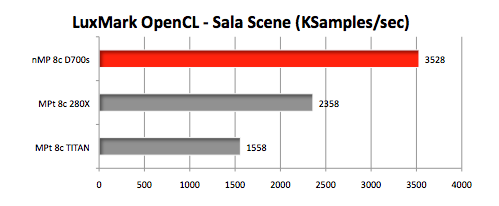
Final Cut Pro X 10.1 features "optimized playback and rendering using dual GPUs in the new Mac Pro." We applied the Gaussian Blur effect to our 1080p two minute sample video. (SMALLER number in Seconds is FASTER.)
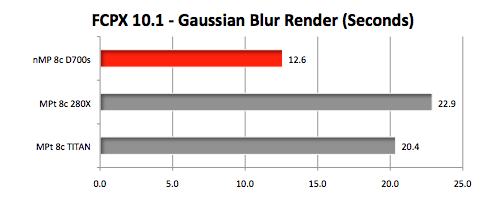
Motion 5.1 -- We rendered the RAM Preview of Atmospheric - Open sample project. (SMALLER number in Seconds is FASTER.)
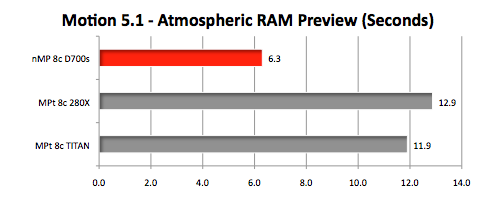
DaVinci Resolve 10 -- Using the ubiquitous Candle project, we measured how fast each setup could playback the 2 minute 1080p sample clip with unrendered effects nodes. (HIGHER number means FASTER in Frames per Second.)
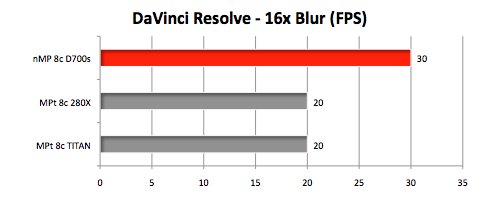
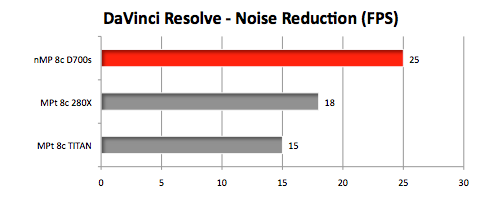
Photoshop CC-- Iris Blur is one of the filters that uses the OpenCL capable GPUs to accelerate the render speed. (LOWER number means FASTER in Seconds.)

Valley -- This non-synthetic OpenGL benchmark does a flyby through complex mountain and forest scenes using multiple OpenGL extensions. (HIGHER number means FASTER in Frames per Second.)
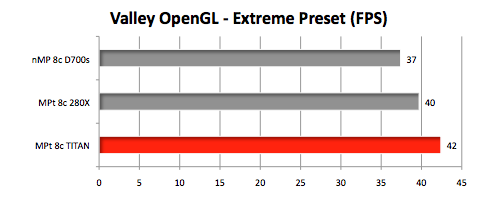
INSIGHTS
When it comes to CPU crunching, the 'late 2013' Mac Pro 8-core was from 21% to 43% faster than the 'early 2009' Mac Pro 8-core.
In the GPU stress tests we chose, the dual FirePro 700s in the 2013 Mac Pro were superior to the single TITAN and single R9 280X in all but the Valley OpenGL test. This weakness showed up in multiple OpenGL game tests until we switched to Windows and ran in CrossFire mode.
Feedback or comments? Contact me
, mad scientist.
Also, you can follow me on Twitter @barefeats